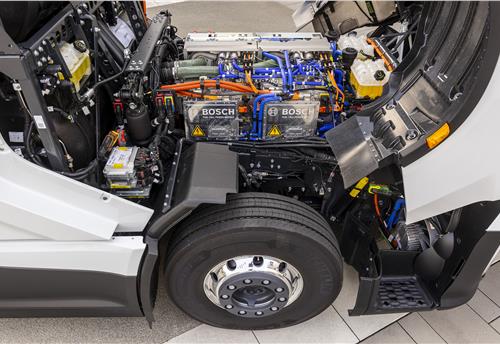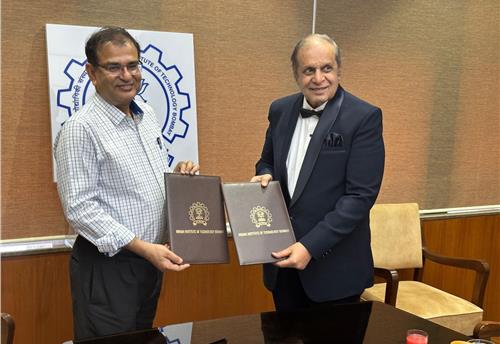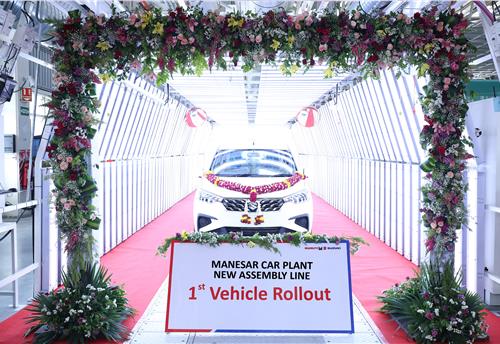Maruti's new Gujarat plant to make 10,000 units in FY’17
When the new Gujarat plant goes on stream in early 2017, the stretched-for-capacity Maruti Suzuki India will breathe a sigh of relief, says Shobha Mathur.
The year 2016 saw Maruti Suzuki India pack a punch. Two premium models –Vitara Brezza and the Baleno – became its key sales drivers. They also signalled the carmaker’s intent to break away from the archaic image of being a mass-market carmaker, which it did to a great extent.
Starting with Auto Expo 2016 in early February, when the company took the covers off its locally developed Vitara Brezza compact SUV, it has been riding a wave of surging sales. Judging by the spiraling waiting periods for the popular sub-4-metre SUV and the premium Baleno hatchback introduced last October, both have struck a double whammy. While sending the cash registers ringing, they have created a humungous demand that the manufacturer found itself ill-equipped to handle, triggering a wait that has climbed to around 6-9 months from about 3-5 months initially.
At present, the Baleno is selling about 10,000 units a month and crossed the 100,000 mark in end- September 2016. The Vitara Brezza crossed the 50,000 mark around the same time, after its launch in March 2016. It is also selling about 10,000 units monthly. The Vitara Brezza incidentally is the first Suzuki model to have been conceived specifically for India but after 30 years. A completely India-designed and developed Suzuki model is yet to be seen though.
What reflects the popularity of these two models is that all this frenetic sales activity happened despite three price hikes during the year that raised their prices between Rs 10,000-16,669 (ex-showroom Delhi). But undeterred prospective buyers continued to book the much-in-demand cars.
Problem of plenty
Maruti had experienced a similar situation when the Celerio AMT hatchback was launched in 2014 amid tight supply of automated manual transmission kits. It sent the waiting period for the car soaring to nine months until Magneti Marelli, the AMT supplier, set up a plant at Manesar to streamline supplies.
While Maruti has battled to increase its deliveries by constant ramp-ups of capacities at both its plants – Manesar which manufactures the Baleno and Gurgaon where the Vitara Brezza is produced – bookings have kept a pace ahead, keeping the OEM on its toes throughout 2016. As a result, the launch of two new models – the Ignis compact urban car and the premium Baleno RS – originally slated for the festive season, was shifted to early 2017.

Another fallout of the long waits bogging the deliveries of the Vitara Brezza and Baleno models was the debilitating impact on Maruti Suzuki’s existing bread-and-butter models – Alto, Wagon R and Swift hatchbacks that shaved off some of their sales month on month.
So where did the math go wrong for the carmaker? Did Maruti Suzuki underestimate consumer demand for the Vitara Brezza and the Baleno?
“Car manufacturing is a serious business,” RS Kalsi, executive director (sales and marketing), Maruti Suzuki India, told Autocar Professional. Bets are high and a lot is at stake while bringing out any new model. Generally, after a lot of deliberations, a volume is worked out, keeping in mind performance of its closest rival model or the best-performing model in the segment. “There’s some flexibility in the plan but if the demand surpasses 20- 25 percent of the forecast, then it starts reflecting in long waiting periods. The response to the Vitara Brezza and Baleno has been overwhelming. Both the models have attained leadership in their segments within a few months of their launch.”
Maruti’s two existing plants, whose combined output stands at 1.55 million units per annum, are believed to be running at full capacity. Capacity can be stretched to a maximum of upto 1.57 million units close to achieving. Further, to streamline supplies of components, it has been working closely with its supply chain to enhance production of the high waitlisted models.
The carmaker has been juggling production or engaging in model sharing between the Baleno and the Swift on the same assembly line, leading to lower volumes of the Swift. In addition, continuous kaizens or improvements are being resorted to, to enhance efficiencies at various stages of production.
This would better the production output and trim wastage. Line adjustments have resulted in another spin off – they have facilitated the company in harmonising domestic and exports demand in case of the Baleno.
Furthermore, the carmaker claims that despite the rising competition in the local market, the Alto and Wagon R continue to hold their positions amongst the country’s five topselling cars among over 200 brands. According to SIAM data, Maruti Suzuki India’s entry level Alto retained its numero uno position between April-November FY2017 with sales of over 162,000 units. The Wagon R sold over 117,000 units in the same period, posting growth of 3.7 percent. "It is the third most-sought-after model in the industry after Alto and Swift Dzire,” says Kalsi.
With seven of its models in the top 10 bestselling list, Maruti Suzuki commands a market share of 47.3 percent in the domestic passenger vehicle market for the period April-November, 2016-17. But the fact remains that volume cuts in production have led to lower sales of these smaller hatchbacks especially the Alto and the Swift. Wagon R numbers have seen intermittent ups and downs. For instance in January 2016, the Alto sold 21,462 units (22,889 units), Wagon R 12,861 (12,744) and Swift 19,669 (14,057 units) while in October that saw Diwali sales, the numbers were as follows: Alto 18,854 units (22,861 units), Wagon R 15,075 units (14,734 units), and Swift 14,611 (17,669 units). The sales graph followed a similar pattern during the year.
Gujarat plant to relieve capacity constraints
Meanwhile, Suzuki Motor Corp’s Gujarat facility that will go on stream at Mehsana in the last quarter of FY2017, will allow elbow space for generating additional capacity for the Baleno. The western facility is pitted to go on stream next January with the Baleno hatchback, easing pressure on the Haryana plants. Maruti is planning to gradually shift the entire production of the Baleno to Gujarat to make space for new models.
The Gujarat plant will also produce the new-generation Swift and Dzire models. If the older versions are phased out, then a lot of capacity will be freed up at Manesar and Gurgaon. It is now confirmed that the sportier Baleno RS will also be made at the Gujarat plant along with its sibling, the existing Baleno.
In early 2014, Osamu Suzuki, chairman of Suzuki Motor Corp, had announced plans to float a subsidiary Suzuki Motor Gujarat (SMG) that would manufacture cars for Maruti Suzuki in Mehsana district of Gujarat. About Rs 3,000 crore would be invested in the new facility by SMG in the first phase, which would produce 250,000 cars annually starting early 2017.
Maruti Suzuki India would instead focus on strengthening its distribution and marketing infrastructure in view of the future growth envisaged in India. It would also earn interest of 8.5 percent on its cash reserves. “Today we sell 1.1 million cars but when the Gujarat plant goes on stream, we will be selling over 2.5 million cars YoY. We cannot sell 2.5 million cars without a proper marketing infrastructure. Any cash surplus of the company will be used in the best way for strengthening the network and in investments,” RC Bhargava, chairman of MSIL, had said at the time.
“Suzuki Motor’s Gujarat plant will commence operations in the last quarter of this fiscal and we expect around 10,000 units in this financial year,” adds Kalsi.
Interestingly, Maruti etched a new milestone during the year when, amidst much fanfare, it flagged off exports of the Baleno hatchback to parent Suzuki in Japan in February.
This was the first time that a ‘Made-in-India car’ has been exported to the parent company. The Baleno is to be exported to 100 countries and Bhargava pointed out, at a recent interaction, that over 2,000 units of the premium hatchback had been exported to Japan till November 2016.
He maintained that it is too early to assess how Japanese consumers have responded to the Baleno as it normally takes a year to make a judgement on the degree of success attained. “Till now, the feedback is that it is okay. I can’t say that exports to Japan are very successful as the Japanese customer is very choosy and does not accept foreign cars very easily. The only foreign brands that are popular and have been successful in Japan are German and US models,” he elaborated.
If the made-in-India Suzuki Baleno finally turns out to be a success in Japan then it would mark a turning point, registering for the first time an Asian manufacturer’s popularity in the Japanese market.
Meanwhile, the company maintains that it has adequate engine capacity to meet demand and it will not be a spoiler in the overall gameplan. So now it's over to 2017 for the next round of action. Stay tuned.
Related:
RELATED ARTICLES
Bosch hydrogen engine tech-powered truck to be on Indian roads this year
The global supplier of technology and services is betting big on both electromobility and hydrogen. While announcing the...
IIT Bombay inaugurates Arun Firodia Research Floor
IIT Bombay, one of India’s top technical and research institutions, honours Kinetic Group chairman Dr Arun Firodia, one ...
Maruti Suzuki expands capacity at Manesar plant by additional 100,000 units
New assembly line at Plant A expands total manufacturing capacity at the Manesar plants to 900,000 units per annum. Alon...





 By Shobha Mathur
By Shobha Mathur
 27 Dec 2016
27 Dec 2016
 9510 Views
9510 Views









